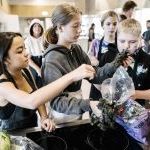Cibo senza sprechi
Il Dipartimento Ambiente e Tecnologia del Comune di Copehagen ha sviluppato tre strumenti specifici per i cittadini che possono aiutare a ridurre gli sprechi alimentari nelle famiglie. Nell'ambito del progetto "Mad Uden Spild" o "Cibo senza sprechi", agli alunni viene consegnata una busta con questi tre strumenti da portare a casa. In questo modo si coinvolgono le famiglie e i loro nuclei familiari. La busta è collegata al materiale didattico per la materia scolastica "cucina e casa", dove i bambini (di età compresa tra i 9 e i 12 anni) vengono istruiti in diversi modi sullo spreco di cibo.
Website
Link utili
Paese
Media
* CONSIGLIO UTILE *
'Coinvolgete alunni e genitori nella riduzione dei rifiuti alimentari per moltiplicare gli sforzi!'
Come si collega il progetto al cambiamento climatico ed alla sostenibilità?
Food waste is a big problem in sustainable development. A critical part of food waste takes place in people's homes. The project is linked to both climate change and sustainability by educating the children in school about why and how tho handle a household with less, or without food waste, and by involving the families with the envelope that the pupils bring home.
Chi è coinvolto?
The municipality, the teachers, the pupils (aged 9-12) and their families.
Come sono coinvolti i partecipanti?
At the start of the project, the municipality of Copenhagen ran a recruitment campaign where they awarded a dinner in the Island Garden for the first school classes to sign up for the programme. The envelope that the pupils take home contains the three tools/principles to guide how to handle a household with less or no foodwaste. There are three principles that showed good results in the private homes in Denmark:
1) I assess the shelf life of my foods before using or throwing them away;
2) I’m aware of what foods in my fridge need to be used soon;
3) I look in my fridge and plan supper a day ahead.
At the same time in school, the children are taught about: how to understand the different date marks; different types of food waste connected to homes; and experiments with durability, packaging and hygiene.
Punti chiave:
Here are some ideas on how you can work with families on reducing food waste:
1. Use the three principles (the municipality could also investigate what works with the households of your community/culture).
2. Create materials with the three guidelines and hand these to children in an envelope to bring home to their families.
3. Develop lessons in school for teaching about food waste to support the work of the children and their families at home.
“It is impressive that you can change your foodwaste by three small principles
– without it having a big impact on your everyday life.” – Participant
“We have received help to create structure. It’s ‘hands on’ what we can do
– it has made a difference. i.e. that we were to put stickers up.” – Participant
“The facts have been pretty cool. ‘Did you know that so much food is being thrown out?’ and ‘If you change this little thing, you can change your consumption by this much’.This I remember and when I speak to friends about it this is also what I want to highlight.” – Participant

